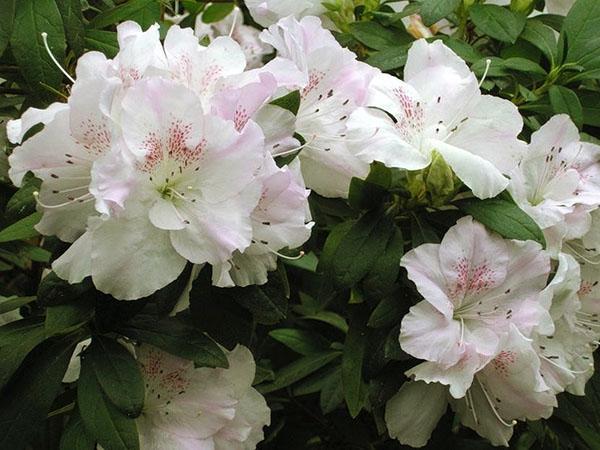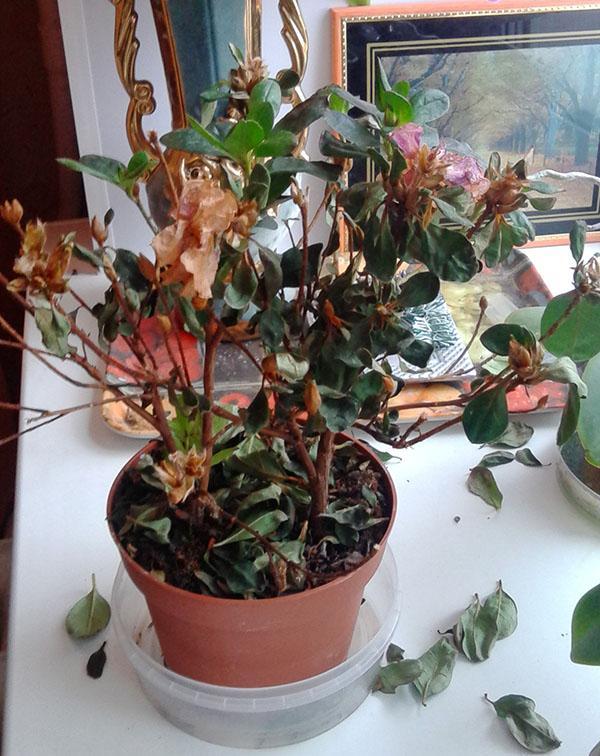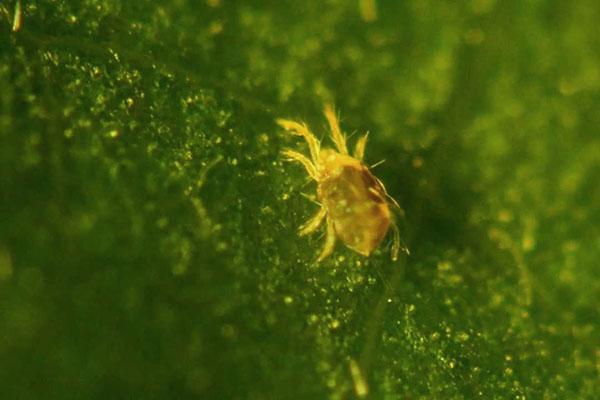How to preserve the beauty of homemade azaleas
 Home azalea is the collective name of varieties originating from two wild species of azaleas - Indian and Japanese. Currently, the genus Azalea is included in the genus Rhododendron, all representatives of which have decorative flowers and need special growing conditions.
Home azalea is the collective name of varieties originating from two wild species of azaleas - Indian and Japanese. Currently, the genus Azalea is included in the genus Rhododendron, all representatives of which have decorative flowers and need special growing conditions.
Violation of the rules of care leads to the fact that the plant quickly loses its decorative effect, the leaves turn yellow, turn black or dry out, and then fall off. Incorrect growing conditions lead to the fact that the azalea weakens, its resistance decreases, and it becomes a target for diseases.
Factors causing the azalea to shed its leaves can be:
- mechanical;
- chemical;
- biological;
- physiological;
- climatic.
Sometimes, several reasons act simultaneously, for example, inadequacy of the climate and damage by pests or infection, to the fall of foliage.
Physiological factors
When growing rhododendrons, you need to remember that these are seasonal plants, and even with proper care, the absence of diseases and good health, homemade azalea partially loses its foliage. This is a natural process - even evergreens must renew their foliage. At the same time, varieties originating from Japanese azalea (Japanese rhododendron) lose more leaves than varieties whose wild ancestor was Indian azalea.
Natural or physiological loss of foliage, in a healthy plant, occurs after flowering, during dormancy. Internal metabolic processes in tissues slow down, but the foliage of the azalea falls off only partially. In this case, in place of fallen leaves, dormant buds are formed. With the beginning of the growing season, new leaves develop from these buds, which will serve the plant for 2-4 years.
Chemical factors
The cause of a toxic burn in a plant may be a poisonous substance that accidentally got into the substrate or on the foliage. But usually, rhododendrons get chemical burns from excessive irrigation with fertilizers. Symptoms of excess chemicals can be that the azalea sheds its leaves, and sometimes dries up and dies.
Azalea should be fertilized very carefully, guided by the rule: "lack of feeding is better than excess."
Another chemical factor is soil acidity. All members of the Heather family need very acidic soil - pH 3.5-4.5. When watering water, soil components are gradually washed out, and the substrate changes its acidity, becoming slightly acidic or neutral. The plant does not receive the necessary root nutrition, since the microscopic soil fungi that provide the life of the azalea die. As a result, azalea leaves fall off and flowers do not form.
How to avoid: the plant should be watered with slightly acidified water, or with special microelements.
Climatic factors

How to avoid: contain azalea at high humidity and a temperature of 12-16 degrees, during the flowering period, during dormancy, the temperature is still reduced (but not lower than + 5).
Insufficient watering, or lack of it for a long time, can also lead to the fact that the azalea shed its leaves.In this case, you need to shorten the shoots a little and resume watering.
Biological factors
The reasons why the azalea dries up, or why its leaves suddenly fall off, can be due to:
- fungal infections (the most common pathogens of flowering plants);
- viral diseases;
- diseases caused by bacteria;
- soil pests that damage the root system;
- parasites that harm only the aerial part.
The prerequisites for the development of all fungal diseases that lead to plant wilting are high substrate moisture, poor drainage and a decrease in temperature. Root rot of rhododendrons, tracheomycosis, late blight (root). Fusarium fungal disease - leads to blackening of the leaves and shoots of the azalea.
Control measures. Preventive measures work most effectively against fungal diseases - to monitor the state of the earthen coma and the well-being of the plant. The soil of the azalea should not dry out, but it should not be too wet. At the first signs of fungal infections, remove the diseased branches and treat the azalea with a solution of a fungicidal preparation. If it is a soil fungus, then you need to replace the substrate and treat the roots with a disinfecting solution (a weak solution of potassium permanganate is suitable).
 A common pest of domestic azaleas, the spider mite, causes the leaves of the plant to wrinkle, turn yellow, wither and fall off. With a strong tick damage, the azalea dries up, and it is not possible to save it.
A common pest of domestic azaleas, the spider mite, causes the leaves of the plant to wrinkle, turn yellow, wither and fall off. With a strong tick damage, the azalea dries up, and it is not possible to save it.
Control measures. At the first signs of the appearance of a parasite (spider webs on leaves, withered leaves and flowers), examine the lower surface of the leaf with a magnifying glass. Ticks are very small, they are not always visible to the naked eye. If a pest is found, the plant must be treated with an acaricidal preparation 2-3 times (the interval between treatments is 3-5 days).
Preventive measures: spray the leaves - the mite reproduces in dry, warm climates.
 The defeat of thrips - a small insect - leads to wilting of the leaves, and with a strong defeat, azalea leaves turn black. Unlike a fungal infection that causes black color, when infected with thrips, the leaves remain dry. Thrips are one of the most dangerous pests, which are very difficult to control due to their resistance to some insecticidal preparations.
The defeat of thrips - a small insect - leads to wilting of the leaves, and with a strong defeat, azalea leaves turn black. Unlike a fungal infection that causes black color, when infected with thrips, the leaves remain dry. Thrips are one of the most dangerous pests, which are very difficult to control due to their resistance to some insecticidal preparations.
Control measures. Treat the plant several times with a special insecticide designed to kill thrips. Be sure to replace the substrate, disinfect the flower pot and plant roots.
 The scale insect is another pest that causes wilting and leaf fall in azaleas. The insect looks like a small oval convex speck that is easy to clean mechanically. The color of this pest can vary depending on the species. As a rule, azalea is affected by a brown and red-brown scale insect, less often green.
The scale insect is another pest that causes wilting and leaf fall in azaleas. The insect looks like a small oval convex speck that is easy to clean mechanically. The color of this pest can vary depending on the species. As a rule, azalea is affected by a brown and red-brown scale insect, less often green.
Control measures. At the initial stage of the lesion, it is enough to wipe the leaves with a cotton swab dipped in soapy water. Then, rinse the plant with water.
In case of severe damage, treat the rhododendron with an insecticide 2-3 times. It is imperative to change the substrate, since the eggs of the scale insects will remain in it, and re-infection will soon occur.
You can use drugs that are absorbed into plant tissue and remain there. This will not harm the azalea, and the scabbard, sucking the poisoned juice from the cells, will die.
In order for the home azalea to remain attractive and healthy, in addition to creating suitable climatic conditions, it is necessary to observe preventive measures and not leave the plant unattended in order to identify pests in time.
Video about growing a beautiful homemade azalea